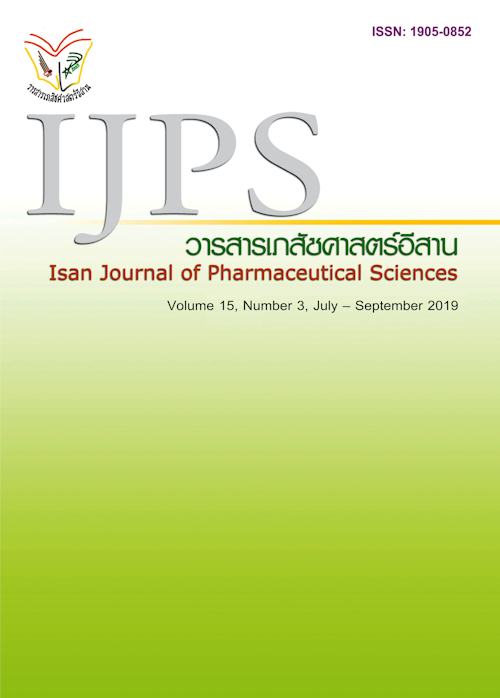Accuracy and precision of the computer program for TDM of vancomycin in pediatric patients
Main Article Content
Abstract
Vancomycin mainly used for methicillin-resistant Staphylococcus aureus (MRSA) treatment. There was sparse data in the pediatrics that have pharmacokinetic variabilities of such patients. Vancomycin is narrow therapeutic index with a risk of severe toxicity. Computer program for therapeutic drug monitoring (TDM) is important for individualized pediatric patients provided the most effective and safety. Objective: To examine the accuracy and precision of the computer program for TDM of vancomycin in pediatric patients. Method: Retrospective study, collected data from vancomycin TDM records in 50 pediatric patients admitted at Queen Sirikit Heart Center of the Northeast aged less than 13 years old and received vancomycin during 16 September 2015 to 31 January 2016. Manually, the Sawchuk-Zaske method was used for pharmacokinetic parameter calculation. The results of manual and computer program calculation were compared using pair t-test statistic at 0.05 significant level Result: All 50 pediatric patients, the mean of elimination rate constant (Ke), half-life (t1/2), maximum and minimum concentration (Cmax, Cmin) calculated using the program calculation were, 0.248±0.07 hr-1,3.131±1.32 hr, 22.112±7.76 mg/L and 6.724±3.83 mg/L, respectively and using the manual calculation were 0.248±0.07 hr-1, 3.131±1.32hr, 22.310±7.59mg/L and 6.724±3.83 mg/L, respectively. The difference between the result of the program and manual calculation is not statistically significant at 0.05 significant level. For speed test of calculation, calculated time per one patient of using program was faster than manual calculation. Conclusion: The pharmacokinetic parameters which calculated by the program and manual calculation was not significantly different and the ability of program calculation is faster more than manual calculation. In the clinical setting, the computer program assisted TDM of vancomycin in pediatrics also can used for assured results that have accuracy and precision and for rapidly calculation.
Article Details
In the case that some parts are used by others The author must Confirm that obtaining permission to use some of the original authors. And must attach evidence That the permission has been included
References
References
Liu C, Bayer A, Cosgrove SE, Daum RS, Fridkin SK, Gorwitz RJ, et al. Clinical practice guidelines by the Infectious Diseases Society of America for the treatment of methicillin-resistant Staphylococcus aureus infections in adults and children. Clin Infect Dis. 2011;52(3).
Fuchs A, Csajka C, Thoma Y, Buclin T, Widmer N. Benchmarking Therapeutic Drug Monitoring Software: A Review of Available Computer Tools. Clin Pharmacokinet. 2013 Jan 30;52(1):9–22.
Preechagoon Y, Hinwiset W, Petcharat S. Computer Program for Designing Appropriate Dosage Regimen of Vancomycin in Post Operative Congenital Heart Disease Pediatric Patients. IJPS. 2015;11(Supplement):404–7.
Marlowe KF, Chicella MF, Claridge TE, Pittman SW. An Assessment of Vancomycin Pharmacokinetic Variability in Pediatric Cardiology Patients. J Pediatr Pharmacol Ther. 2003;8(2):132–6.
Kim DIL, Im MS, Choi JH, Lee J, Choi EH, Lee HJ. Therapeutic monitoring of vancomycin according to initial dosing regimen in pediatric patients. Korean J Pediatr. 2010;53(12):1000–5.
Zhao W, Lopez E, Biran V, Durrmeyer X, Fakhoury M, Jacqz-aigrain E. Vancomycin continuous infusion in neonates : dosing optimisation and therapeutic drug monitoring. Arch Dis Child. 2013;98:449–53.
Hoang J, Dersch-Mills D, Bresee L, Kraft T, Vanderkooi OG. Achieving therapeutic vancomycin levels in pediatric patients. Can J Hosp Pharm. 2014;67(6):416–22.
Durham SH, Simmons ML, Mulherin DW, Foland JA. An evaluation of vancomycin dosing for complicated infections in pediatric patients. Hosp Pediatr. 2015;5(5):276–81.
Marqués-Miñana MR, Saadeddin A, Peris JE. Population pharmacokinetic analysis of vancomycin in neonates. A new proposal of initial dosage guideline. Br J Clin Pharmacol. 2010;70(5):713–20.


